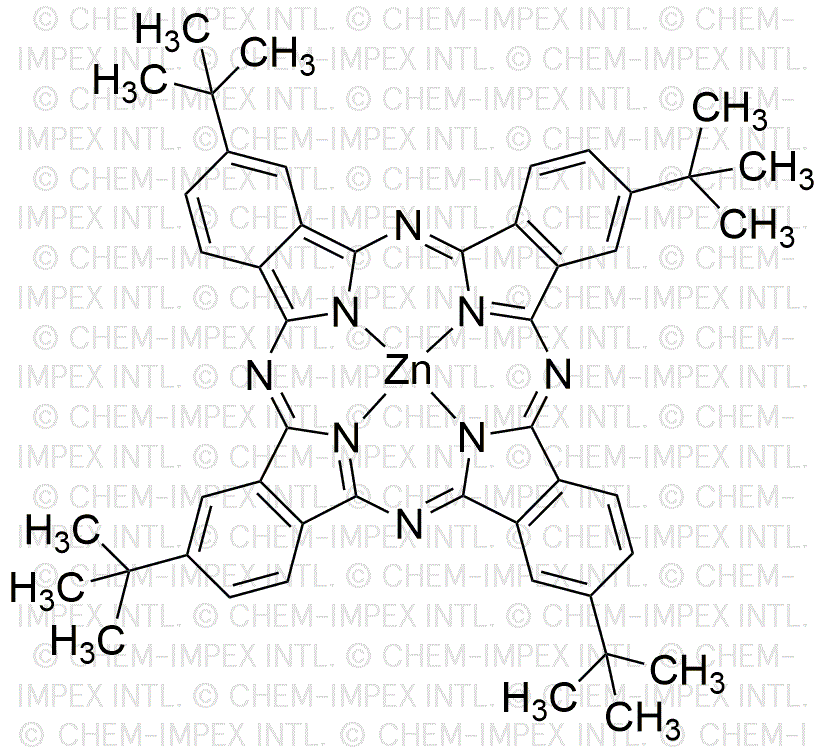Zinc(II) 2,9,16,23-(tetra-tert-butyl)phthalocyanine is widely utilized in research focused on:
- Photovoltaic Applications: This compound is used in the development of organic solar cells, enhancing light absorption and improving energy conversion efficiency.
- Catalysis: It serves as a catalyst in various chemical reactions, particularly in organic synthesis, due to its ability to facilitate electron transfer processes.
- Biomedical Imaging: The compound is explored for its potential in imaging applications, such as photodynamic therapy, where it can help target and destroy cancer cells using light.
- Colorants and Dyes: It is utilized in the production of high-performance pigments for plastics and coatings, offering excellent thermal stability and colorfastness.
- Electronics: This chemical is incorporated in the manufacturing of electronic devices, particularly in organic light-emitting diodes (OLEDs), due to its favorable electronic properties.
General Information
Properties
Safety and Regulations
Applications
Zinc(II) 2,9,16,23-(tetra-tert-butyl)phthalocyanine is widely utilized in research focused on:
- Photovoltaic Applications: This compound is used in the development of organic solar cells, enhancing light absorption and improving energy conversion efficiency.
- Catalysis: It serves as a catalyst in various chemical reactions, particularly in organic synthesis, due to its ability to facilitate electron transfer processes.
- Biomedical Imaging: The compound is explored for its potential in imaging applications, such as photodynamic therapy, where it can help target and destroy cancer cells using light.
- Colorants and Dyes: It is utilized in the production of high-performance pigments for plastics and coatings, offering excellent thermal stability and colorfastness.
- Electronics: This chemical is incorporated in the manufacturing of electronic devices, particularly in organic light-emitting diodes (OLEDs), due to its favorable electronic properties.
Documents
Safety Data Sheets (SDS)
The SDS provides comprehensive safety information on handling, storage, and disposal of the product.
Product Specification (PS)
The PS provides a comprehensive breakdown of the product’s properties, including chemical composition, physical state, purity, and storage requirements. It also details acceptable quality ranges and the product's intended applications.
Certificates of Analysis (COA)
Search for Certificates of Analysis (COA) by entering the products Lot Number. Lot and Batch Numbers can be found on a product’s label following the words ‘Lot’ or ‘Batch’.
*Catalog Number
*Lot Number
Certificates Of Origin (COO)
This COO confirms the country where the product was manufactured, and also details the materials and components used in it and whether it is derived from natural, synthetic, or other specific sources. This certificate may be required for customs, trade, and regulatory compliance.
*Catalog Number
*Lot Number
Safety Data Sheets (SDS)
The SDS provides comprehensive safety information on handling, storage, and disposal of the product.
DownloadProduct Specification (PS)
The PS provides a comprehensive breakdown of the product’s properties, including chemical composition, physical state, purity, and storage requirements. It also details acceptable quality ranges and the product's intended applications.
DownloadCertificates of Analysis (COA)
Search for Certificates of Analysis (COA) by entering the products Lot Number. Lot and Batch Numbers can be found on a product’s label following the words ‘Lot’ or ‘Batch’.
*Catalog Number
*Lot Number
Certificates Of Origin (COO)
This COO confirms the country where the product was manufactured, and also details the materials and components used in it and whether it is derived from natural, synthetic, or other specific sources. This certificate may be required for customs, trade, and regulatory compliance.


